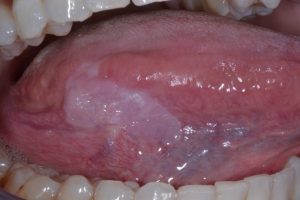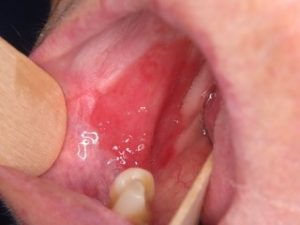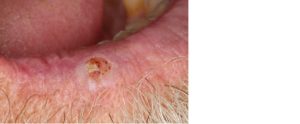
24 Jul Oral, Head and Neck Cancer Awareness Week at Boulton Dental
By Jessy Kozak, Emily Smith, and Heather Verrell
Important roles dental professionals play in screening Oral, Head and Neck Cancer.
Dental professionals including dentists, oral health therapists and hygienists are one of the only health professionals to examine the mouth routinely. This provides a significant opportunity to screen for oral lesions and cancer.
50% of oral cancers develop from small less sinister looking lesions. Therefore, early detection, management and preventative action play a crucial role in treatment.
Signs and symptoms
Oral cancer can develop in all areas of the mouth including lips, cheeks, tongue, throat, floor of mouth, tonsils, salivary glands, pharynx, larynx and even your sinuses. It is important to recognise any possible symptoms to ensure a visit to your dentist as soon as possible for a comprehensive screening and examination.
Oral cancer symptoms can be similar or disguise themselves as other problems, for example, a sore throat or a small bump.
Usually, symptoms will persist for longer periods, in which case an assessment should be booked in with your dentist.
Signs and symptoms may include:
- Lump in neck or mouth.
- Difficulty swallowing or chewing.
- Changes to voice
- White or red patches in the mouth
- Sore that doesn’t heal
- Numbness
- Unexplained weight loss
- Sore throat or persistent feeling of being caught in the throat.
Common Oral premalignant lesions
Exploring common oral premalignant lesions through images provides valuable visual insights into these potentially concerning conditions.
Image: Leukoplakia on tongue – white or gray patches that do not go away
Image: Erythroplakia on cheek -Flat or slightly raised areas that are red and may bleed
Image: Submucous fibrosis on cheek – white, mottled or marbled patches
Image: Lichen planus on cheek – White, lace- like patches
Image: Discoid lupus erythematosus on palate – red patch with spots of white surrounding
Image: Squamous cell carcinoma on lip – thick, scab like texture with uneven border
Image: Ulcer on lip – white/red in color and does not heal
Image: Human Papillomavirus – red or white raised wart presentation
Risk factors for oral cancer
Understanding the risk factors associated with oral cancer is crucial for early detection and prevention. Several factors contribute to the development of oral cancer, including:
- Smoking and tobacco chewing
- Alcohol
- Sun exposure to the lips
- Human papillomavirus (HPV) or oral warts
- HIV
- Epstein-Barr virus (EBV)
- Age, genetics, gender, and poor oral and general health
When you should get checked
Book in with your dentist for a regular checkup and clean. Routinely having examinations and screening is the best way to prevent late diagnosis. Consult your general practitioner or dentist if you find a spot that concerns you or start displaying symptoms of mouth cancer.
How to prevent mouth cancer
Statistically in Australia, 1 in 58 people were diagnosed with mouth cancer in 2022; 59% caused by smoking, 31% alcohol, and UV exposure in Australia were the main causes.
Quitting smoking, reducing alcohol intake and wearing sunscreen and protective clothing are important steps towards prevention.
At Boulton Dental, every patient at their checkup has an oral cancer screening.
Your dentist or dental hygienist/dental therapist should perform an oral cancer screen at each examination appointment.
During this time, they will check:
- Soft tissues in and around your mouth (lips, gums, tongue, cheeks, floor of the mouth), under your jaw and in some cases your neck, checking for any lumps or bumps.
- Ask you about some of the risk factors associated with oral cancers.
- Check for any changes in the oral mucosa which can be red or white in colour and present in a range of different shapes. By checking each patient this will lead to early detection of oral cancer.
- If an ulcer or sore is noticed in the mouth it should heal within 1-2 weeks. If it doesn’t clear it is best to get it reviewed by the dental team.
- Before brushing your teeth, a good habit to develop is to look around your mouth, lifting the lips, sticking out your tongue and pulling out the cheeks.
Oral cancer equates to 3.2% of all new cancer diagnoses each year in Australia in 2022 and is the 6th most common cancer worldwide.
Before starting cancer treatment, a full oral health check is recommended so any treatment can be done prior to the being of radiotherapy.
What happens if something is found during an oral cancer screen?
Your dental professional should let you know if a lesion is found in your mouth at the time of screening. In many cases, they will simply make a note of it and perhaps take a photo and review the lesion at a follow up appointment.
They may refer you to a specialist if the lesion has not disappeared or looks suspicious. The specialist will look at the lesion, discuss your individual risk factors with you, and likely take a biopsy of the area of abnormal cells.
This will help determine if the lesion is cancerous or not. The specialist will then be able to discuss further with you what the next step will be for you. They will also let your general dental professional who referred you what the diagnosis is and whether any further treatment is required.
If you are unsure if you have ever received an oral cancer screen, or have any questions, please ask your dental professional.
At Boulton Dental, oral cancer screenings are a regular part of our service and we are always happy to answer any questions you may have about your oral health. The dental staff here at Boulton regularly update their knowledge on oral cancer so that we can provide you with the best possible preventive and early diagnosis care.
How do head and neck cancers affect the mouth?
The most common treatment for head and neck is radiation which can affect the teeth and oral cavity.
During radiation treatment, patients may experience:
- Ulcers
- Dry mouth
- Loss or change of taste
When a person has a dry mouth, the risk of tooth decay, tooth wear, gum disease and infection increase.
To moisten the mouth, we recommend trying OH! Care HA-X Gel – Gum Serum or mouthwash.
These products contain hyaluronic acid used to relieve dry mouth symptoms, heal mouth ulcers and sore mouths caused by cancer treatments.
Boulton Dental provides comprehensive and thorough oral, head, and neck cancer screening at every appointment. Our dentists, oral health therapists and hygienists are all highly trained to detect signs and symptoms of mouth cancer and can ensure quick specialist referral and advice.
Sources:
1. Mavedatnia, D. et al. (2023) ‘Oral cancer screening knowledge and practices among dental
professionals at the University of Toronto’, BMC Oral Health, 23(1). doi:10.1186/s12903-
023-03062-3.
2. Irani, S. (2020) ‘New insights into oral cancer—risk factors and prevention: A review of
literature’, International Journal of Preventive Medicine, 11(1), p. 202.
doi:10.4103/ijpvm.ijpvm_403_18.
3. Mouth cancer: Causes, symptoms & treatments (2023) Cancer Council. Available at:
https://www.cancer.org.au/cancer-information/types-of-cancer/mouth-cancer (Accessed:
14 July 2023).
4. Warnakulasuriya, S. and Kerr, A.R. (2021) ‘Oral cancer screening: Past, present, and future’,
Journal of Dental Research, 100(12), pp. 1313–1320. doi:10.1177/00220345211014795.









Sorry, the comment form is closed at this time.